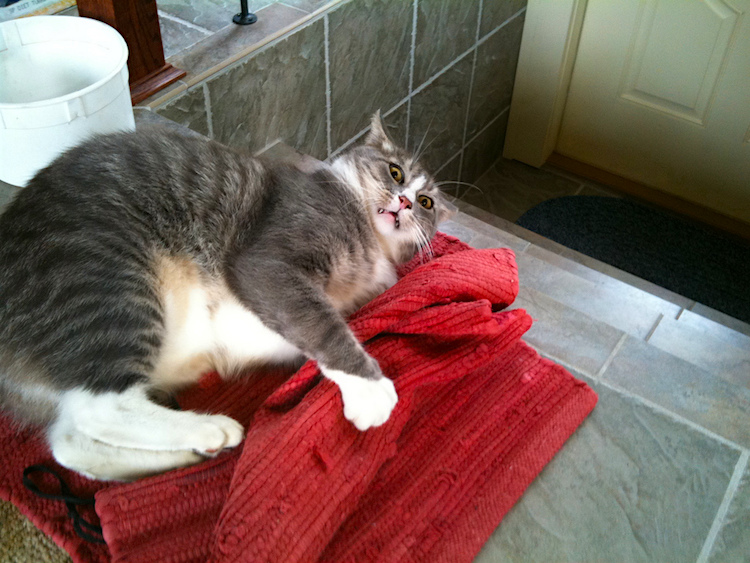
If you have a cat, it’s a good bet you’ve seen the following:
All is quiet, when suddenly your cat comes racing into the room, scuffles around a bit and then tears out as if they’ve just heard that there’s a free catnip giveaway.
- Is there another animal lurking?
- Could it be the need to burn off excess energy?
- Is there a ghost in the house?
Not to fear, your cat is OK — and they (probably) aren’t seeing ghosts either.
There are a few reasons why your cat may get the “zoomies” out of nowhere, as we’ll explain in this article.
Why Does My Cat Go Crazy and Run Around?
1. Pent-up Energy
The most logical explanation is that this behavior could simply be pent-up energy in your cat.
Cats spend lots of time lying around just watching the world go by. But they do have energy to burn just like any other animal.
The racing around could be a way of burning off that pent-up energy.
Makes sense, right?
Cats “tend to be more active when we’re more active,” says cat researcher Mikel Delgado,1 a postdoctoral fellow at the School of Veterinary Medicine at the University of California Davis.
Because most people are at work all day, Delgado says, “when they get home … cats have all that energy stored up from lounging all day.”
This is especially true for indoor cats.2 And while younger cats obviously have more energy to burn, even senior cats have been known to zoom around like crazy every once in a while.
This video shows a hilarious compilation of cats racing around their houses like crazy:

2. Intruders Inside and Out
Another animal’s scent could be the reason your cat is running around like crazy.
If there are other animals inside the house or outside the window, it could be triggering your cat’s behavior.
Your home, inside and out, is an area your cat considers their territory. It can be maddening to see another animal blithely tromping all over said territory.3
A good indicator is seeing your cat racing from window to window and even meowing loudly enough to shake the rafters (who knew cats could be so loud?).
3. Chasing Prey
Or, your crazy-acting cat could be — unfortunately for you squeamish people out there — reacting to the scent of prey.4
Was YOUR Pet Food Recalled?
Check Now: Blue Buffalo • Science Diet • Purina • Wellness • 4health • Canine Carry Outs • Friskies • Taste of the Wild • See 200+ more brands…

Mice are a common problem in just about any area, but especially rural areas. Mice give off a distinct odor to cats and are their natural prey, so it makes sense that your cat will go nuts trying to find them and catch them.
And if you’re lucky, your cat will share them with you (yuck).
Not only is this an explanation for the cat zoomies, but it’s also a great indicator of a pest control issue.
You might want to hire a pest control service to come out and take a look, especially if you’re like me and refuse to go within 10 feet of a mouse.

4. Pesky Little Fleas
Your cat could in fact have fleas.
As any of us who have been bitten know, it’s a sharp little pain that comes along with every bite, and those bites can get really annoying quickly.
Flea infestations can happen quickly — even if your cat lives indoors-only — so it’s important to treat your cat as soon as you notice the problem.
Fleas make your cat “terribly uncomfortable,” according to the Cornell Feline Health Center5 — and in severe cases can cause pain from the constant flea bites and the cat’s subsequent scratching.
5. Other Reasons
If none of the above seem to apply to your cat and you are sincerely concerned, it’s never a bad idea to talk with your veterinarian about the reasons behind your cat running around like crazy.
One possible medical explanation for overactive behavior in a cat is hyperthyroidism.6 Hyperthyroidism tends to occur in senior cats, according to Dr. Pippa Elliott, BVMS, MRCVS.
“Cats with hyperthyroidism don’t sleep very much and will have a voracious appetite,” says Dr. Erin Wilson, DVM, medical director of the New York ASPCA.
Another disorder, hyperesthesia syndrome,7 is a mysterious condition that can sometimes make a cat react this way. The disease can cause the skin along the spine of your cat to ripple or roll. Other behaviors can manifest, too:
- Excessive grooming
- Licking
- Biting
- Scratching
- Racing around the house
- Chasing their tail
Not much is known about this condition, only that it is possibly an aspect of obsessive-compulsive (OCD) behavior or a seizure disorder.
Your veterinarian can help you determine if this is something your cat is experiencing.
References
- Paoletta, Rae. “Why Your Cat Runs Around at Night Like a Maniac, According to Science.” Inverse. Dec. 19, 2017. https://www.inverse.com/article/39459-why-does-my-cat-run-around-at-night-according-to-science.
- Becker, Marty, DVM, and Gina Spadafori. MeowWOW!: Curiously Compelling Facts, True Tales, and Trivia Even Your Cat Won’t Know. Health Communications, Inc. 2007. 16–17.
- Sung, Wailani, MS, PhD, DVM, DACVB. “Help! My Indoor Cat Is Being Tormented by an Outdoor Cat.” Vetstreet. Nov 4, 2015. http://www.vetstreet.com/our-pet-experts/help-my-indoor-cat-is-being-tormented-by-an-outdoor-cat.
- Bradshaw, John. Cat Sense: How the New Feline Science Can Make You a Better Friend to Your Pet. Basic Books. 2013. 116.
- Cornell Feline Health Center. “Fleas: A Source of Torment for Your Cat.” Cornell University College of Veterinary Medicine. https://www.vet.cornell.edu/departments-centers-and-institutes/cornell-feline-health-center/health-information/feline-health-topics/fleas-source-torment-your-cat.
- Chan, Christina. “5 Ways to Calm Down a Crazy Cat.” PetMD. https://www.petmd.com/cat/behavior/5-ways-calm-down-crazy-cat.
- Cornell Feline Health Center. “Hyperesthesia Syndrome.” Cornell University College of Veterinary Medicine. https://www2.vet.cornell.edu/departments-centers-and-institutes/cornell-feline-health-center/health-information/feline-health-topics/hyperesthesia-syndrome.
* * *
This article was originally published in 2011 and is regularly updated. It was last reviewed for accuracy and updated Aug. 28, 2019.


